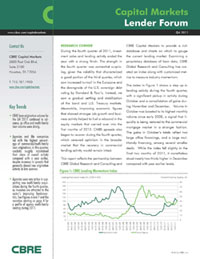
The multifamily industry is on an ascending path, with trendlines pointing to a steady, albeit slow, recovery of the housing market all throughout the U.S metro areas.
The construction pipeline remains active in most markets, with 1,400 properties, 316,010 units, currently under construction, according to the latest data from Pierce-Eislen. The company’s services monitor the 50+ unit apartment universe from the property level to the submarket/market level within 59 United States markets, extending in geography from the Pacific Northwest to the Mid-Atlantic.
Denver, L.A. Metro, Seattle and the Carolina Triangle lead the charts in terms of new apartment development, followed closely by Washington D.C., Northern Virginia, Urban Boston, and three of Texas’s economic hubs, North Dallas, Austin and West Houston.
Common Characteristics
Pierce-Eislen research shows that more than 90 percent of the units under construction possess two characteristics in common: the developments are located in urban environments, and they are positioned so as to serve the two, “renters-by-choice” lifestyle rental categories: wealthy empty nesters (55+), and young professional, double-income-no-kids-households.
The capital source, lender, developer, investor universe all seem to point to the same conclusion: urban, cutting-edge development, fully dressed up, with all the amenities is the one configuration that actually works in the current economic context.
On the other hand, when conducting quarterly comparisons of market data, the apartment industry conditions seem to be weakening. All four indexes of the National Multi Housing Council’s (NMHC) October Survey of Apartment Market Conditions dropped below 50 for the first time since July 2009. Market Tightness (46), Sales Volume (46), Equity Financing (39) and Debt Financing (41) all showed declining conditions from the previous quarter.
“After four years of almost continuous improvement across all indicators, apartment markets have taken a small step back,” said Mark Obrinsky, NMHC’s Vice President of Research and Chief Economist, in a statement. “Conditions cannot continue to improve indefinitely and new development is at least somewhat constrained by available capital – though more on the equity than the debt side. Even so, both the Market Tightness and Sales Volume Index are within hailing distance of the breakeven level and the Debt Financing Index rose despite some rise in interest rates. This bodes well for the apartment industry going forward.”
Key findings of the NMHC survey include:
Mixed sentiments regarding the availability of capital for new development. More than three quarters of the respondents regarded construction debt financing as widely available – 34 percent think both equity and debt financing are widely available, while 43 percent think construction loans are widely available but equity capital for new development is constrained. Only 36 percent think equity capital is widely available.
Market Tightness Index fell to 46 from 55. Conditions vary greatly from place to place, but on balance, most respondents (67 percent) said they saw no change in market tightness (higher rents and/or occupancy rates) compared with three months ago. One-fifth of respondents felt that markets were looser than three months ago, while 13 percent saw tighter markets.
The Sales Volume Index remained at 46. Almost one-third (32 percent) of respondents saw a lower number of property sales, compared with almost one-quarter (24 percent) who said sales volume was unchanged. A plurality of 44 percent regarded sales volume as unchanged.
The Equity Financing Index dipped to 39. Sixty percent viewed equity financing as unchanged – this was the tenth consecutive quarter in which the most common response was that equity finance conditions were unchanged from three months ago. By comparison, 27 percent of respondents viewed conditions as less available and only 5 percent viewed equity financing as more available.
Debt Financing Index rose 21 points to 41. Almost one quarter of respondents (22 percent) viewed conditions as better from three months ago, a sizable increase from eight percent last quarter. Forty-one percent of respondents believed now is a worse time to borrow, down from 67 percent in July.
The survey was conducted October 7-October 16 and included the responses of 64 CEOs and other senior executives of apartment-related firms nationwide.


















